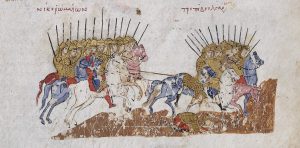Banu Ziri, part of the Talkata branch of the Sanhadja (Ṣanhājah) Berber group, were one of the tribal allies of the Fatimids, whose power base at the time was in Ifriqiya (Ifrīqīyah) (Tunisia and eastern Algeria), against the Umayyad Caliphs of Cordoba and their Berber tribal allies in the Central Maghreb in the second half of the 10th century (General History of Africa III, 323 & 328). Their base was in the Kabylie mountainous region of central Algeria, as was the location of their first capital, Ashir (E. Britannica “Zirid Dynasty”). For his significant help during the Abu Yazid revolt (943/4-947/8) that nearly destroyed the Fatimids, Ziri ibn Manad was granted command over all the Sanhadja and their territories effectively gaining control of western parts of the Fatimid domains and being appointed as the guardian of the western frontiers of the Fatimid lands. After the revolt, Ziri, who died in battle in 971, and his son Bulukkin led a campaign against Zanata and Maghrawa Berber tribes, both independently and alongside Fatimid armies to curb their influence in Algeria and to expand westward (General History of Africa III, 328-329).
Having recuperated after the Abu Yazid revolt, Fatimids launched their first successful attack on Egypt which came under their rule in 969 and became their power base in 972. In the same year, Caliph al-Mui’ziz granted Bulukkin ibn Ziri (972-984 CE) dominion over the entire western part of the Caliphate (Ifriqiya). In that moment, the Zirids became the first Berber dynasty to rule in Maghreb, first as Fatimid vassals and later as independent rulers (General History of Africa III, 328-329). Bulukkin continued the westward expansion and by 980 the Zirids controlled most of Morocco (Naylor, 2009, 79 & 84). Kayrawan (al-Qayrawān) became their new capital sometime after the Fatimids moved to Egypt at the end of the 10th century (E. Britannica “Zirid Dynasty”; Qantara “The Zirids and the Hammadids (972-1152)”).
The first three Zirids (Bulukkin, al-Mansur and Badis) strengthened their control over Ifriqiya, without causing open conflict with the Fatimids in Cairo. However, there were conflicts, the first conflict happened when al-Mansur ibn Bulukkin (984-996 CE) deposed an important representative of the Fatimids in Ifriqiya (sent by the Fatimids to supervise their emirs). Some historians believe that this action by al-Mansur means that he did not consider himself a simple administrator to be dismissed at a whim but an actual ruler. Surprisingly, Fatimids did not react to his action with direct and open hostility, but they did send a da’i to the Kutama tribe with instructions to revolt against al-Mansur. The Kutama tribe revolted in 986 but failed in their task and were brutally suppressed, becoming a minor factor in the region as a result (General History of Africa III, 329).
A small group of Zirids, led by Zawi ibn Ziri, fought for the Umayyad Caliph in Iberia in the beginning of the 11th century. In about a decade, they managed to establish their own dynasty and rule with success from Granada starting in 1012 (Qantara “The Zirids and the Hammadids (972-1152)”; E.Britannica ”Zirid Dynasty”).
After a major Zanata incursion into Zirid territory and Hammad ibn Bulukkin’s campaign against the Zanata, Badis ibn Mansur (996-1016 CE) was forced to hand over large areas of central Maghreb to his uncle Hammad. With those areas and his own capital of Kal’a (Al-Qal’a, 1007), Hammad (1015-1028 CE) proclaimed his independence in 1014 by severing all relations with the Fatimids and swearing his allegiance to the Abbasid Caliph (Naylor, 2009, 84). Although Badis showed less independence and was rewarded with the province of Barka, the Fatimids did not help him deal with Hammad despite Hammad’s open declaration of allegiance to the Abbasid Caliph. Reasons for Fatimid inaction remain unclear; focus on the eastern border, loss of Ifriqiya’s economical/demographical importance and Fatimid inability to militarily intervene are some of the historians’ theories (General History of Africa III, 329-330; Qantara “The Zirids and the Hammadids (972-1152)”).
Although Hammad was defeated in the end by Badis’ heir, al-Mu’izz ibn Badis (1016-1062 CE), the split in the Zirid dynasty was confirmed in 1018 and the Hammadid branch remained independent. Hammad’s actions caused religious turmoil in Ifriqiya and the mostly Sunni population (Naylor, 2009, 79) started actively opposing the Zirids and their Shia Fatimid overlords which led to thousands of dead Shi’ites. No doubt with this in mind, al-Mu’izz followed Hammad’s suit and changed his allegiance to the Abbasid Caliph in 1047. However, Hammad changed his decision and his son, al-Ka’id (1028-1054 CE), changed his allegiance twice, first to the Abbasids and then to the Fatimids. While Hammadids were constantly in conflict with the Zanata and other western tribes and sometimes with the Zirids in the east, Zirid lands enjoyed a period of stability even after their break with the Fatimids in 1047 (General History of Africa III, 329-332).

Source: General History of Africa III, p. 316.
Fatimid response came a couple of years later. Banu Hilal and Banu Sulaym were nomadic Arab Bedouin tribes in the Upper Egypt that were persuaded to migrate westward by the Fatimid vizier al-Yazuri. Nomadic tribes have been known as a very unstable element in any organized state which, combined with their habit of plundering the lands they migrate to and their nomadic lifestyle, means they would not be very useful in regaining lost lands for the Fatimids. This draws the conclusion that al-Yazuri’s plan was vengeance and not reclamation of lost territories. Vanguard of the tribes arrived in Zirids’ eastern province of Barka and pillaged it in 1050/1. Banu Hilal moved onward while the Banu Sulaym remained in the province for some time. When Banu Hilal reached southern Tunisia, al-Mu’izz wanted to recruit them as allies and invited them into his domain. In a short amount of time, the tribe overran southern Tunisia capturing and pillaging villages and towns. Al-Mu’izz’s military response failed quickly (battle of Haydaran in 1051/2), as did his diplomatic efforts and submission to the Fatimids in 1054/5 which left him no choice but to abandon his capital Kayrawan (1057), which was sacked immediately after, and move to al-Mahdiyya from where he ruled over a fraction of his former emirate (General History of Africa III, 330-333, Naylor, 2009, 84 & 85).
Hammadids under al-Nasir (1062-1088 CE) had a little more success in hiring the Banu Hilal Arabs and had fought alongside them against other Arab groups in the region but in doing so gave them even more power which produced the same result as it did for al-Mu’izz (General History of Africa III, 333; Naylor, 2009, 85 & 271). In 1090, Kal’a and southern lands were left to the nomads and Hammadids continued their rule from recently founded city of Bidjaya. In the same year the Zirids in Iberia were overthrown by the Almoravids (E. Britannica “Zirid Dynasty”).
The situation in the region was chaotic, all fertile land belonged to the nomadic Bedouins, agriculture was almost abandoned and, despite the reduction in trade since the trade routes from the east had become very insecure, piracy became a very profitable occupation (E. Britannica “Zirid Dynasty”; General History of Africa III, 334).
Zirid and Hammadid states never recovered from the Bedouin invasion and were reduced to several coastal towns and ports and a few barely significant settlements inland. However, the Hammadid city of Bidjaya did have better local resources such as wood for ships and a better geographical position for trade than al-Mahdiyya which allowed them to fare a little better, even managing to capture and hold Djerba Island (General History of Africa III, 335). Zirids fell to the Normans in 1148, Hammadids to the Almohads in 1151 and Bedouins founded many smaller and consistently feuding principalities which continued to destabilise and devastate the region until the arrival of Berber Almoravids from Morocco in the first half of the 12th century. By the mid-12th century, Almoravids in the region were overthrown by the other Berber Muslim dynasty, the Almohads (General History of Africa III, 333-334; Naylor, 2009, 85, 93 & 94).
Literature
General History of Africa III: Africa from the seventh to the eleventh century. ed. Elfasi, M., Ivan Hrbek. Paris: UNESCO, 1988.
Naylor, Phillip Chiviges. North Africa: a history from antiquity to the present 1st ed. Austin: University of Texas Press, 2009.
Qantara “The Zirids and the Hammadids (972-1152)” https://www.qantara-med.org/public/
show_document.php?do_id=596&lang=en (last visit: December 1st, 2018).
,,Zirid Dynasty” Encyclopaedia Britannica 2018 (https://www.britannica.com/topic/Zirid-Dynasty (last visit: December 1st, 2018).
Autor:
Recenzenti:
- Dominik Pešut, voditelj projekta, voditelj recenzijskog tima;
- Mihaela Marić, članica recenzijskog tima;
- dr. sc. Hrvoje Gračanin, stručni recenzent.
Ovaj esej objavljen je u Anno Domini Enciklopediji, dijelu međunarodnog projekta Anno Domini, na gromovnik.hr – mrežnoj stranici Udruge “Gromovnik”.



